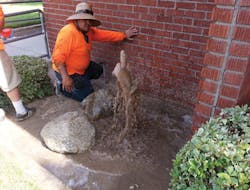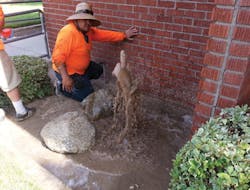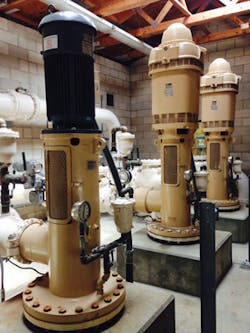By Art Haddaway, WaterWorld Editor
Over the last several years, the Central Basin Municipal Water District (CBMWD) of California has made great strides in implementing innovative approaches to improve water efficiency and better serve its municipal, commercial and industrial customers throughout the region. Through its recycling projects, outreach and educational programs, and strategic conservation initiatives, the District has contributed to important water-related developments across its service territory.
CBMWD is a public agency that wholesales imported water to private companies, mutual water businesses and investor-owned utilities, among other entities, throughout southeast Los Angeles County. Serving a population of more than 2 million people in 24 cities, CBMWD manages the water supply for an area that expands 227 square miles and uses approximately 315,000 acre-feet of water annually -- a sector that ultimately demands high water and energy consumption.
To ensure a safe and reliable water supply for this region, one particular area of focus that CBMWD has recently targeted is capitalizing on the relationship between water and energy by implementing a groundbreaking new water-energy sustainability program. The Water and Energy Emergency End Use Demand Management Measure Project (MMP), as it's termed, is a $2-million grant provided by the U.S. Department of Energy (DOE) designed to significantly reduce water and energy consumption across the county.
Awarded to the District in July 2010, the MMP has made history as the first grant to successfully be administered by a water agency that minimizes water and energy usage simultaneously, essentially helping to strengthen the water and energy conservation nexus. The funds are being used to retrofit public agency facilities, install an advanced notification awareness program, and incorporate software and hardware to manage how water is used in its recycled water delivery system.
These efforts are helping to safeguard water resources, improve customer service, operate and maintain equipment and infrastructure, and more. "The overarching purpose of the MMP is to increase water-use efficiency while reducing energy consumption in the southeast Los Angeles region," said Sandi Linares-Plimpton, conservation and outreach officer for CBMWD. "The MMP meets the District's goal to achieve regional suitability; however, it has the added benefit that it reduces energy use, thus bridging the water and energy nexus."
CBMWD initially accepted the funding under DOE's Energy Efficiency and Conservation Block Grant Program and also received nearly $1 million from the Proposition 50 Large Landscape Integrated Water Management Program, awarded by the California Department of Water Resources (DWR) in 2007, explained Linares-Plimpton. Since receiving the funds, the District has made several revisions to the project to help meet its goals and community needs and increase compatibility with its existing infrastructure, she said.
The relationship between water and energy is collaborative and interdependent. In fact, where there's energy, there's almost always water -- the two are intricately interwoven. In the case of CBMWD, its staff pointed out that water can be used for energy production, and energy is required for water treatment, conveyance and conditioning. The MMP endeavor capitalizes on this approach and incorporates effective best management practices to conserve water and energy on a large scale.
The program is divided into two elements -- potable water and recycled water -- which encompass a wide range of concentrated efforts that contribute to CBMWD's ongoing sustainability strategies. The potable water portion of the grant includes the Conservation Retrofit Project, Conservation Awareness Program and Drought-Tolerant Demonstration Gardens and Landscape Workshops, while the recycled water aspect covers a supervisory control and data acquisition (SCADA) system, SCADA Integrated Asset Management Program and Peak Demand Management Project, according to the CBMWD.
The Conservation Retrofit Project helps publicly owned sites, such as schools, realize water savings by auditing their existing indoor and outdoor water devices. For example, the District recently retrofitted water fixtures at 37 school sites with high-efficiency washers, faucet aerators and weather-based irrigation controllers, to name a few. According to CBMWD, some properties have already seen up to a 50-percent water use reduction as a result.
"Public schools were the focus of this program because such sites have a high water usage and often have limited financial resources that impede their ability to transition to water efficient operations," said Linares-Plimpton. "As a part of this project, public schools received free audits to help determine the best approach for water savings. Depending on their needs, schools were provided with retrofits at no cost."
The District's Conservation Awareness Program also helps raise awareness of water and energy conservation by notifying the public of important information, such as drought conditions, ordinances for water use and helpful conservation tools, via a web-based platform. This allows water providers to access crucial material in one place, as well as communicate with and provide real-time data to their customers.
In addition to CBMWD's conservation retrofit and awareness programs, its Drought-Tolerant Demonstration Gardens and Landscape Workshops also help preserve water by featuring attractive water-efficient landscapes for the public to use for recreational and educational purposes. These gardens, reconstructed from existing landscapes, not only save water but also highlight the state's native plants and serve as an efficient model for outdoor horticulture.
"The purpose of this program is to provide the community with a tangible example of a garden that is both beautiful and water-efficient," said Linares-Plimpton. "Some community members have a limited perception of drought-tolerant landscaping, and this program will help the community see the benefits of this type of garden design."
Along with CBMWD's potable water applications, its customized SCADA system also helps optimize the functionality of the recycled water distribution system. The District incorporated the technology as a means to improve the functionality of equipment in the recycled water system, which can, in turn, lead to more efficient water and energy use. This involves the SCADA Integrated Asset Management Program, a computer software platform used to manage assets such as valves and pumps in the distribution system.
For example, CBMWD's recycled water pumps cycle on and off, hindering potential energy savings and increasing wear on equipment. The SCADA and SCADA Integrated Asset Management Program solution contributes to system reliability by adjusting the pumping schedules and ultimately enables staff to manage and comprehend data more productively and regulate challenging equipment conditions more effectively.
The District's Peak Demand Management Project will help by monitoring water use through a voluntary schedule that alternates when CBMWD's eight large recycled-water purchasers actually consume the treated resource. This may eliminate the possibility of two or more locations drawing water at the same time, thus lowering pumping needs and reducing energy peaks, explained Albert Plimpton, Information Technology and Building manager for CBMWD.
"Every water drop treated and distributed requires some form of energy expense. The idea behind the project as a whole is that by conserving water, energy is saved by not needing to treat, pump and distribute the water to customers," he said. "There will be an energy savings with all of the project efforts. Overall, with SCADA, asset management and conservation, we anticipate energy savings in every area for both the recycled water element and the potable water element."
CBMWD completed the MMP in October 2014 after receiving time extensions from the DOE and DWR. According to Plimpton, the total $2 million awarded from the grant was used in full, and the remaining monies provided by DWR are expected be disbursed in 2016. Going forward, Linares-Plimpton noted that the MMP has opened the door for new and unique collaboration among communities throughout southeast Los Angeles County toward reducing their water and energy footprint.
"The MMP demonstrates that science, community and education are needed to significantly scale up implementation of water-efficiency projects," she said. Further, it "shows that both community and individual behavior matters to water-energy efficiency as an integrated system -- the water-energy nexus. It empowers each and every citizen of the district to reduce demands for energy and water, encouraging everyone to do their part for long-term sustainability of community resources."
With regard to its impact on other communities across the nation, Linares-Plimpton added that the MMP sets a new industry standard for various water establishments to follow. "This project is an example of how other agencies can develop projects that tie in multiple resources," she said. "Central Basin has been submitting abstracts to multiple industry-recognized conferences, where staff will have the opportunity to speak to nationwide industry professionals and provide guidance on how this project may be applied in other agencies."
More WaterWorld Current Issue Articles
More WaterWorld Archives Issue Articles







